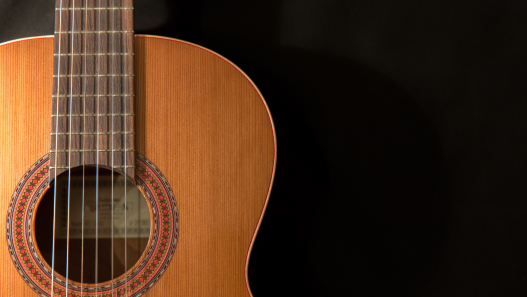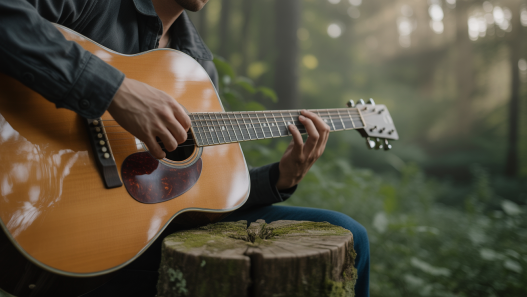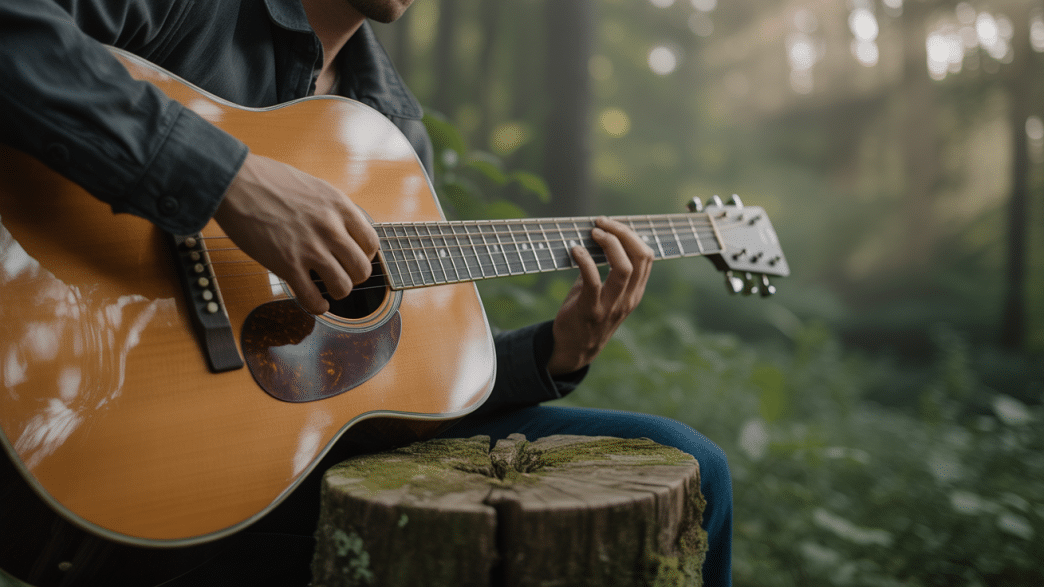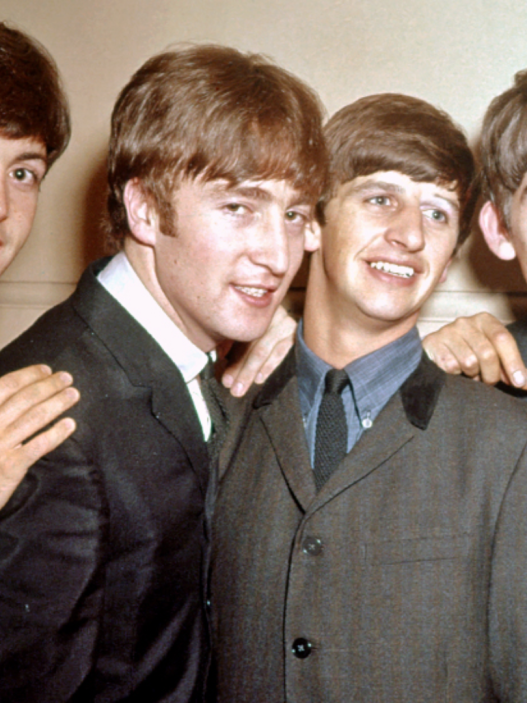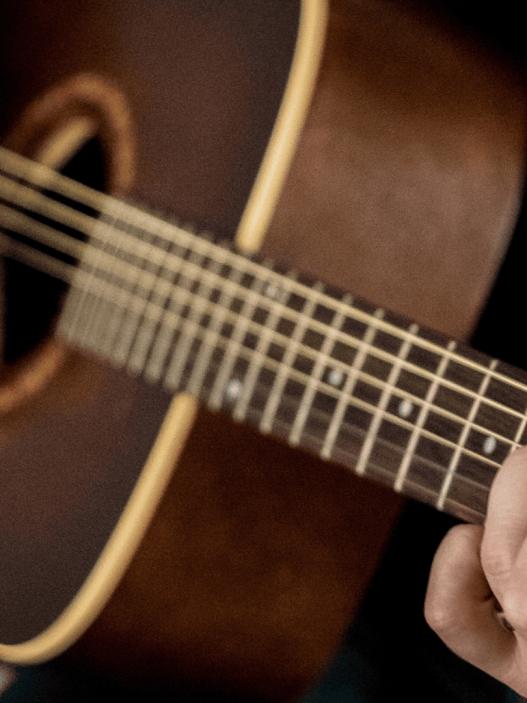That haunting, open sound you hear in your favorite acoustic songs? There’s a good chance it’s DADGAD tuning working its magic.
DADGAD might seem like a puzzle at first. Standard tuning feels safe and familiar, but this alternate tuning can leave even experienced players feeling lost. The fretboard looks the same, but everything sounds different.
Here’s the thing: DADGAD isn’t as complicated as it seems. Once you know the right chords, it becomes your secret weapon for creating rich, layered sounds that standard tuning can’t match.
This guide breaks down the essential chords every guitarist should know in DADGAD. No fancy theory or confusing explanations. Just the practical, useful chords that will transform how you play acoustic guitar.
Ready to unlock those beautiful, resonant tones? Let’s get your fingers moving on the fretboard.
How to Tune Your Guitar to DADGAD
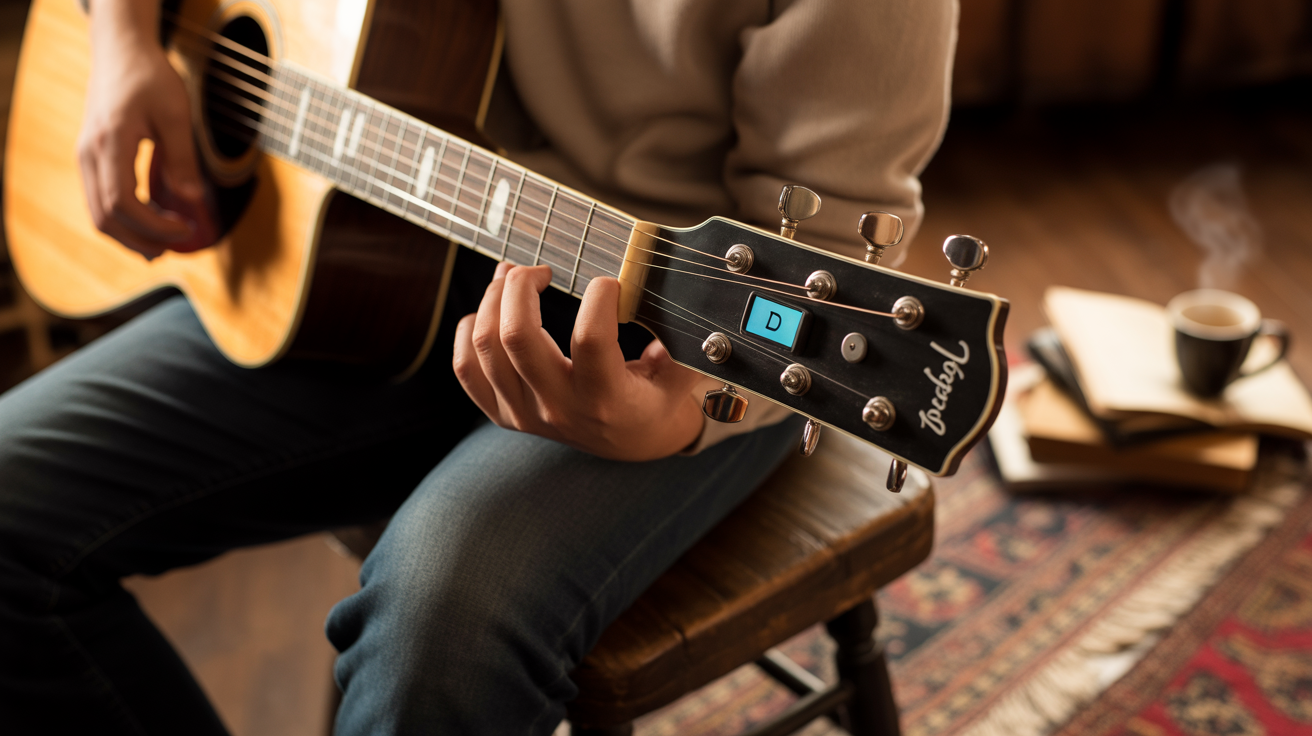
DADGAD tuning is a popular alternate tuning for the guitar that opens up rich, droning chords and modal voicings often used in Celtic, folk, and fingerstyle music.
Transitioning from standard tuning (EADGBE) to DADGAD is simple if you follow these steps carefully.
From Standard Tuning to DADGAD
Here’s how to change each string:
| Standard Tuning | DADGAD Tuning | Change Needed |
|---|---|---|
| 6th String: E | D | Tune down a whole step |
| 5th String: A | A | No change |
| 4th String: D | D | No change |
| 3rd String: G | G | No change |
| 2nd String: B | A | Tune down a whole step |
| 1st String: E | D | Tune down a whole step |
Why Use DADGAD Tuning?

DADGAD tuning isn’t just a style, it’s a creative playground for guitarists seeking fresh harmonies. By returning three strings, you unlock an open Dsus4 chord that invites rich drones and simplifies complex fingerings.
This tuning is loved in Celtic, folk, and world music, and is also favored by modern fingerstyle players and composers who crave texture and fluid transitions.
Whether you improvise modal melodies or compose layered arrangements, DADGAD offers a unique voice that encourages exploration.
Benefits of DADGAD Tuning
-
Richer harmonic textures – The open Dsus4 base adds natural suspense and depth to chords.
-
Easier drone-based playing – D and A strings stay in place, perfect for continuous drone notes.
-
Fingerstyle-friendly layout – Chord shapes and melodic runs often require fewer fingers.
-
Modal improvisation made simple – Great for D major, D mixolydian, and Dorian modes.
-
Simplified chord transitions – Many progressions feel smoother and more intuitive than in standard tuning.
-
Creative inspiration – Stepping away from familiar shapes can spark new song ideas instantly.
Ultimate DADGAD Chord Shape Guide
A complete table of must-know Major, Minor, Power, Drone, Suspended, and Add9 chords in DADGAD tuning. Perfect for acoustic creativity, fingerstyle, and dynamic rhythm playing.
| Chord | Fingering (6→1) | Type | Sound & Usage |
|---|---|---|---|
| D Major | 0 0 0 2 3 0 | Major | Bright and open; base chord of DADGAD tuning |
| G Major | 5 5 0 0 0 3 | Major | Rich drone effect, common in folk and ambient |
| A Major | 7 7 7 6 5 0 | Major | Bold and ringing; works well for full-sounding strums |
| F Major | 3 3 3 2 1 0 | Major | Dense and compact; nice for darker progressions |
| B Minor | 4 2 0 4 0 0 | Minor | Somber tone; fits emotional or modal playing |
| E Minor | 2 2 2 0 0 0 | Minor | Simple and open; easy transition from D |
| A Minor | 7 7 7 5 5 5 | Minor | Soft and expressive; ideal for fingerpicking |
| D5 Power Chord | 0 0 0 x x x | Power | Strong and simple; great for rhythm emphasis |
| G5 Power Chord | 5 5 0 x x x | Power | Deep, chunky tone; movable shape for riffs |
| A5 Power Chord | 7 7 0 x x x | Power | Punchy and bright; great for acoustic strumming |
| D Drone (Root) | 0 0 0 x x 0 | Drone | Layer with melodies; creates resonance and space |
| D Drone (High) | x x x 0 3 0 | Drone | Adds melodic shimmer, common in fingerstyle |
| Dsus4 | 0 0 0 2 3 3 | Suspended | Classic DADGAD flavor; creates suspended emotional tension |
| Gsus4 | 5 5 0 0 3 3 | Suspended | Sweet and unresolved; great in ambient sections |
| Dadd9 | 0 0 0 2 0 0 | Add9 | Dreamy and open; ideal for ballads and soft textures |
| Aadd9 | 7 7 7 6 0 0 | Add9 | Lush and flowing, it adds sparkle to A major voicing |
Easy Chord Progressions to Try
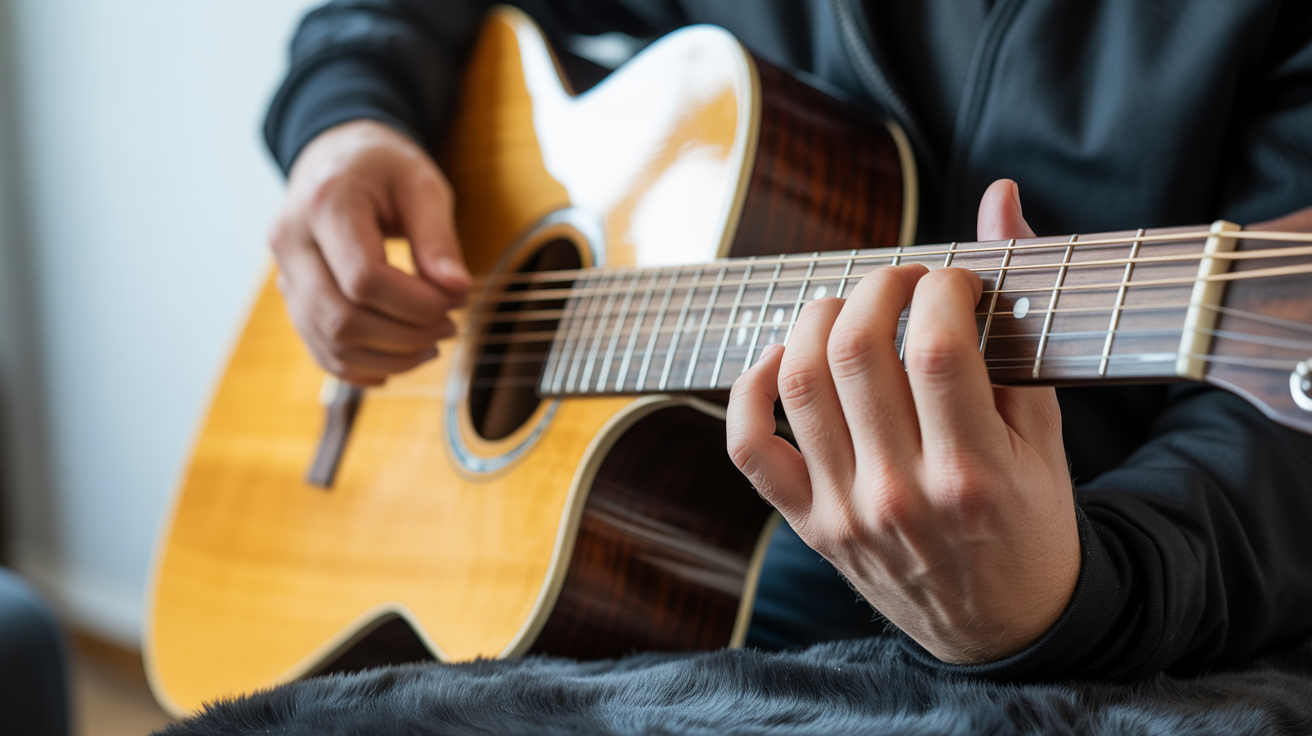
DADGAD tuning is a goldmine for creating lush, emotive progressions—even with just a few chords.
Here are 5 beginner-friendly progressions that sound great and feel natural under your fingers. Perfect for strumming, fingerpicking, or exploring dynamics.
1. D – G – A
Feel: Uplifting, open, and folk-inspired
Use: Great for intro songs, sing-alongs, and feel-good acoustic jams
Tip: Try a simple down-down-up-up-down pattern or pick individual strings to let the drone ring out.
2. D – Bm – G – A
Feel: Emotional and cinematic
Use: Ideal for storytelling, ballads, or moody transitions
Tip: Fingerpick to highlight the minor-to-major contrast, or strum gently with dynamics.
3. Em – G – D – A
Feel: Reflective with subtle tension and release
Use: Great for acoustic verses and fingerstyle melodies
Tip: Use your thumb for bass notes and fingers for melody to create a flowing texture.
4. D – Dsus4 – Dadd9 – D
Feel: Suspended and ambient
Use: Perfect for intros, ambient interludes, or filmic sections
Tip: Let each chord ring out fully—this one shines when played slowly and softly.
5. G5 – A5 – D – Bm
Feel: Driving and rhythmic
Use: Works well in instrumental builds or rhythmic acoustic grooves
Tip: Use palm-muted strums to emphasize the power chord energy, then open up for the D and Bm.
Tips for Practicing DADGAD Chords

DADGAD tuning invites a more intuitive, experimental approach to the guitar. Here are some focused strategies to help you develop smooth technique and creative fluency.
1. Focus on Transitions: Isolate chord changes (like D to G or Bm to A) and repeat them slowly. Pay attention to finger placement and string clarity to avoid muddy overtones.
2. Use a Capo for Exploration: Place a capo on different frets to explore new keys without learning new shapes. This is a great tool for vocalists and songwriters looking to vary arrangements.
3. Play with Harmonics: Try harmonics on the 5th, 7th, and 12th frets. DADGAD naturally enhances these tones, making them perfect for adding ambient textures or intro riffs.
4. Incorporate It Into Songwriting: Don’t just practice, create. Let the tuning guide your songwriting, using its rich voicings to craft original melodies and chord progressions.
Famous Songs in DADGAD Tuning
DADGAD tuning has shaped the sound of many memorable acoustic and rock compositions.
Below are some well-known songs that showcase their unique voicing and drone-rich sound. Try listening to these tracks and experiment with playing parts of them to get a feel for the tuning.
1. Kashmir – Led Zeppelin
This legendary riff-driven track uses DADGAD to create a hypnotic, Middle Eastern-inspired groove. The tuning gives the guitar its powerful, open-string resonance that pairs perfectly with orchestral layering.
2. The Last Pint – Pierre Bensusan
Pierre Bensusan is a master of DADGAD, and this tune captures the intricate fingerstyle and Celtic beauty the tuning allows. It’s a great study in melody and drone interplay.
3. Black Mountain Side – Led Zeppelin
Jimmy Page returns to DADGAD in this acoustic instrumental piece, rooted in folk and Indian classical influences. It’s a perfect example of modal exploration through open strings.
4. Midsummer Day – Richard Thompson
This track combines storytelling with rich, rhythmic playing in DADGAD. Thompson’s use of partial chords and open textures makes it engaging for fingerstyle players.
Wrapping Up: Unlocking New Soundscapes
Your fingers might feel clumsy at first with these new chord shapes. That’s totally normal.
DADGAD tuning opens up a whole new world of sounds that standard tuning can’t touch. The chords covered here give you a solid foundation to build on.
Start with the basic open chords. Get comfortable with how they feel under your fingers. Once those become second nature, the more complex shapes will click into place.
The best part? These chords work great together. Mix and match them to create your progressions. You’ll be surprised how quickly they start to feel natural.
Ready to put these chords to work? Drop a comment below with your favorite DADGAD chord from this list. Want more alternative tuning tips? Check out our other guitar guides for fresh inspiration.






